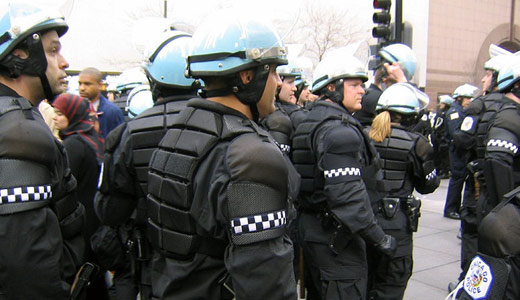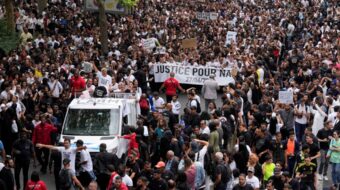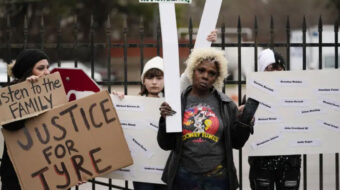
CHICAGO – Alton Logan spent 26 years in prison for a crime he didn’t commit. He was denied a fair trial because evidence exonerating him was concealed by officers of the Chicago Police Department (CPD).
He certainly wouldn’t be shocked by the results of a new study documenting a history of CPD corruption, brutality, murder and criminal cover-up.
The study by a team of researchers at the University of Illinois – Chicago (UIC), was released the same day the Chicago City Council was finalizing a payment of $33 million to Logan and Christina Eilman, another victim of police criminality.
The UIC study concluded the criminality is so systemic within the police force that it will take total governmental commitment and an outside entity to correct it.
The report confirms conclusions of previous studies and what is taken for granted in the African American and Latino communities, among civil rights and liberties organizations. It broadly links police corruption and brutality and the racism deeply embedded in the department.
“The police in the African American community have always acted with impunity,” said Frank Chapman, a leader of the Chicago Alliance Against Racist and Political Repression (CAARPR). ” (The police) could shoot a child and get away with it. They are one of the last vestiges of racist institutions in this country. “
“The fight to end brutality and corruption is a fight for basic democratic rights,” said Chapman.
He and the CAARPR are doing something about it. On Feb. 23 a 2nd People’s Hearing on Police Crimes that will be held at the University of Chicago, where many victims and their families will testify and next steps in the campaign for democratic accountability of the police will be outlined.
“The response of the community has been tremendous,” said Chapman. “They are saying, ‘we want to do something about this.'”
The UIC study reviews some 300 convictions of police crimes dating back to the 1960s such as “drug dealing, beatings of civilians, destroying evidence, protecting mobsters, theft and murder.”
The study acknowledges the extent of criminality may never be known because most crimes have never been investigated. Instead they have been covered-up by the famed “blue wall of silence,” abetted by police higher-ups, district attorneys and mayoral administrations.
Besides notorious CPD Commander Jon Burge, no police have ever been brought to justice for the heinous torture crimes against over 200 mostly African American males while in police custody between 1972-1991. The men were tortured into making false confessions and many spent decades in prison for crimes they didn’t commit.
Burge was convicted only of perjury and obstruction of justice. The statute of limitations has run out on the torture crimes.
Nor does the study document recent police frame-ups of innocent political activists, including 5 arrests stemming from the May 2012 anti-NATO protests.
But the report does recount the existence of the “Red Squad” during the 1970s that kept files on over 100,000 activists and thousands of organizations and how the CPD committed the premeditated murders of Fred Hampton and Mark Clark, leaders of the Black Panthers.
Police brutality is costly to the victims, communities and city. The City of Chicago has spent $82 million over the last 10 years to settle lawsuits from victims of torture, abuse and police misconduct. Cases involving Burge have cost the city $63 million since 1998.
The report traces the history of corruption back 100 years and shows it was joined at the hip to the famed Chicago political “Machine” and organized crime, known in Chicago as the “Outfit.”
It connects the more recent explosion of police criminality and abuse with the “War on Drugs” beginning under the first Mayor Richard Daley that targeted the African American and Latino communities. This led inevitably to collusion of a substantial number of police with street level gangs and radically heightened racist practices in the force.
“It is widely known actual gang members have infiltrated the police,” said Chapman. “Corrupt police protect drug dealers and some of police killings are gang related. This is nothing new. It happened with the mob in New York City.”
It’s no surprise that most of the victims of police torture, abuse and criminality are African American or Latino.
The UIC study shows that every effort to curb police corruption has been a failure because investigations and discipline are police investigating police.
“Even when the superintendent of police recommends the firing of corrupt police officers, the Police Board overturns the superintendent in 63 percent of the cases,” Simpson said. The Chicago Justice Project found that, in 20 percent of the cases officers testifying under oath, the board returned the officer to work with no discipline whatsoever.
University of Chicago law professor Craig Futterman found only 19 of 10,149 (or less than 2 percent) civilian complaints of excessive force, illegal searches, racial abuse, sexual abuse and false arrests between 2002 and 2004 led to police suspensions of a week or more.
The study argues for the creation of an independent civilian body as one key solution. It recognizes the proposal championed by the CAARPR, for the establishment of a Civilian Police Accountability Council (CPAC), democratic bodies in each police district that would be composed of representatives elected from the community.
In addition to building support for CPAC, Chapman said complaints will be filed with the U.S. Department of Justice and a petition will be delivered to the United Nations Commission on Human Rights.
“What you have here is a gross violation of the civil rights of U.S. citizens and residents and human rights,” said Chapman. “We need to deal with that as well.”
Photo: Noah Coffey // CC 2.0

MOST POPULAR TODAY

Zionist organizations leading campaign to stop ceasefire resolutions in D.C. area

High Court essentially bans demonstrations, freedom of assembly in Deep South


Afghanistan’s socialist years: The promising future killed off by U.S. imperialism

Communist Karol Cariola elected president of Chile’s legislature






Comments